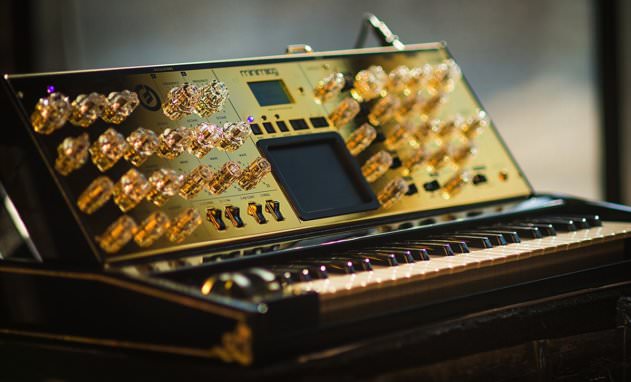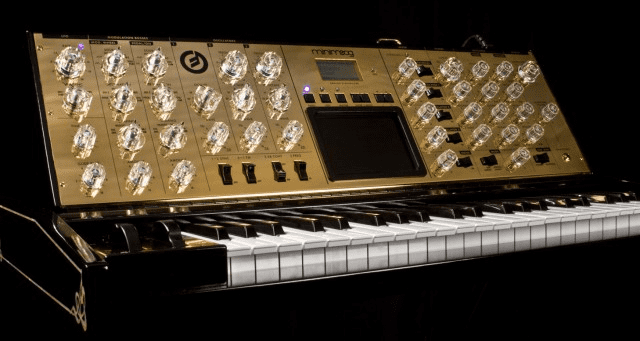Greg Scarth shines a spotlight on some of the most desirable drum machines, the most sought-after synths and the most valuable vintage electronic music gear money can buy.

In February 2008, a violin made in 1742 by Giuseppe Guarneri del Gesù, protege of famed Italian luthier Antonio Stradivari, sold at auction for $3.9m (nearly £2m), setting a new record* for the most expensive musical instrument ever sold. The instrument’s price was boosted by several crucial factors: scarcity (only around 140 Guarneri instruments survive, compared to around 640 Strads), quality, and a large number of wealthy collectors actively looking to purchase items of its type. The instrument’s buyer, Russian lawyer Maxim Viktorov, later hosted a special performance by Israeli virtuoso Pinchas Zukerman in order to show off his purchase to an audience of invited guests.
For obvious reasons, market prices of synths and drum machines are yet to reach quite such stratospheric heights. As enjoyable as it might be to imagine a Russian lawyer spending millions on, say, an immaculate Roland TR-909 and inviting Richie Hawtin to give a live Plastikman performance at the Bolshoi Theatre, it seems unlikely.
However, interest in contemporary music memorabilia and equipment is increasing year by year. Rock and pop memorabilia from the 60s and 70s is now big business. In 2000, George Michael paid £1.45m ($2.1m) for the Steinway piano on which John Lennon wrote ‘Imagine’. Interest in electronic gear seems to be following a similar path. Brian Eno’s EMS Synthi AKS recently sold for nearly £17k, much more than double the typical selling price. It’s not too much of a stretch to suggest that as the teenage music fans of the 70s and 80s grow older and find themselves with greater disposable income, interest in electronic music gear – especially gear with an interesting provenance – will rise to reflect the musical tastes of the typical collector.
Imagine a Russian lawyer spending millions on a 909 and inviting Richie Hawtin to give a live performance at the Bolshoi Theatre.
Just as importantly, interest from musicians is as strong as ever. Possibly even more so. Prices of analogue equipment in particular have been rising since the 1990s as producers increasingly realise that the only way to capture the authentic sound of classic electronic music hardware is to get hold of the real thing. Synths and drum machines may not command the same prices as antique violins, vintage electric guitars and ex-Beatles’ pianos, but they continue to appreciate exponentially.
In this feature we’ll shine the spotlight on some of the most desirable electronic music gear money can buy, including a couple of new pieces along with the vintage goodies. They aren’t necessarily the most expensive pieces of kit – that list would probably be a rather tedious rundown of mixing consoles – but they’re examples of some of the most sought-after electronic instruments in existence. In the process, we’ll investigate the factors which determine a synth, drum machine or sampler’s desirability, and try to address the question of whether music gear really represents a good investment.
Thanks to Roger Linn, Dave Smith, Peter Forrest of Vemia, Marc and Mark of Funky Junk, Johan Antoni of Syntotek, Moog Music and Roland UK for their assistance in researching this feature.
* The record was broken in 2011 by a Stradivarius, but charity auctions are a less accurate indicator of true market value.

07.09 AM
Fantastically thorough look into the value behind mouth-watering gearporn. Now time to start saving… ;-(
01.26 PM
Didn’t herbie hancock demo that Fairlight sampler on Sesame Street
01.30 PM
He certainly did, alongside a young Tatyana Ali (Ashley from The Fresh Prince Of Bel Air): http://www.youtube.com/watch?v=oKoisNv1ftw
This video of him showing it off to Quincy Jones is also excellent: http://www.youtube.com/watch?v=n6QsusDS_8A
02.35 PM
no Waldorf Wave?!
02.44 PM
The Wave’s definitely right up there with the best of them.
It’d be great to hear all your thoughts on this from a practical perspective too. As amazing as, say, a CS-80 is, would it necessarily be at the top of your shopping list if you won the lottery? We’ve got a feeling a lot of producers are probably more interested in slightly more affordable classics when it comes to actually making music…
12.09 PM
What about the GX1?
05.01 PM
I enjoyed this article as I continue to with Attack’s interviews and insightful cultural articles..
In addition to the vintage/analogue gear, I’d add some modern controllers to the list which have huge expressive capabilities not available on the mass market, such as polyphonic pitchbend and sensing on multiple axes. For example, the Haken Continuum is US$5,290 (without its case or stand). The newly-introduced ROLI Seaboard Grand is US$8,888.88. Those are the prices of decent used cars.
The CS-80 is an curious example of how performance controllers have regressed in some ways in the decades to come. How it takes something like an Arturia Origin (itself US$3,000) to include all those kinds of controllers. Not as much of a price delta change as you’d expect, given progress with home computers.
While some contemporary tech like touchscreens thrive (tablet market demand, thanks iPads!) and the DJ market has seen interesting plays (Maschine’s rise despite doubters re: the Akai dynasty), more specialized-to-music stuff languishes or is still available at very high prices. I figure there needs to be more popular education for new instruments to resolve part of this chicken-and-egg Gordian knot — otherwise most people, clinging onto the familiar piano form, are too scared to transition to it, keeping prices high.
02.44 PM
Great point, Torley. Things like the Continuum and Seaboard are very niche products, but to a certain type of performer or musician they’re truly desirable – partly because there aren’t many alternatives at any price point.
But you also hit on another interesting point. The touchscreen revolution led by the iPad virtually destroyed another product – JazzMutant’s Lemur controller, which eventually returned, slightly ironically, as an iOS app. And that trend for premium products to be replaced by cheaper alternatives is definitely mirrored in other markets – Maschine undercutting the MPCs, Moog introducing the Sub Phatty and dropping the Little Phatty, and so on (that’s without mentioning software, of course).
There really aren’t actually many super high-end synths around any more. There are products like the Prophet 12, SE CODE, Voyager XL, etc, but while the market for budget (<£500) and mid-range (£500-1000) synths seems to be thriving, anything larger is a much riskier proposition for any company.
Dave Smith acknowledged in our interview that the numbers today are much smaller, and that's despite the fact that synths are much cheaper in real terms than they were back in the 70s. Even with today's advances, the question of whether the market for a truly expressive, powerful performance-based synth in the vein of the CS-80 would still exist is open to debate.
03.17 PM
No GXs? No paper face Serge or Music Easel ? No Wave? No Fenix? And no Synthi 100?
12.54 PM
EMS?
05.01 AM
Wow! My CS-80’s “Slave to the Bass” video is posted here. (Blushes). It is a magnificent instrument. I used to sit in front of PBS Cosmos with Carl Sagan for a mind melding experience in the early 80’s after school. Our console TV had a good 6×9 speaker. Never expected to find a CS-80 of my own. I do not believe 2000 were ever made. So far, all functional CS-80’s are between serial numbers 1000-1800. It is believed that less than 800 were made. Cost prohibitive. There are 45 circuit boards, stuffed to the gills. Over 1200 internal trim pots to calibrate.
08.05 PM
https://www.youtube.com/watch?v=5esV1RiIB8o